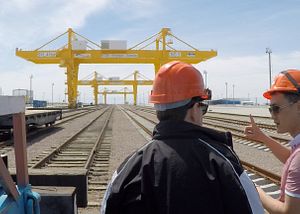A recent European study on sustainable transport connections with Central Asia concluded that the Central Trans-Caspian Network (CTCN), crossing southern Kazakhstan, provides the “most sustainable transport connections between Europe and Central Asia,” particularly when a “two-layer catchment” area that spans 300 km north and 600 km south of the core route — hereby touching on all five Central Asia states — is taken into account. This so-called Middle Corridor encompasses four of Central Asia’s five most populous cities (Tashkent, Almaty, Bishkek, and Shymkent).
The study, funded by the European Commission with an eye toward implementing both the 2019 EU Strategy on Central Asia and the 2021 Global Gateway Strategy, was carried out by the European Bank for Reconstruction and Development (EBRD) over a period of time stretching from November 2021 to June 2023. The 55-page report assess several transport route options and for the route deemed “most sustainable” — the CTCN — offers proposed actions to develop the route, including both soft connectivity (i.e. the enabling environment) and hard connectivity (i.e. physical infrastructure) aspects. In terms of hard connectivity, the study identified 33 infrastructure investment needs in the region; in terms of soft connectivity, seven coordinated actions were identified.
In framing the expected benefits of greater cooperation, the study drew directly on a distinctly European experience:
As seen in the successful example of connecting the 27 EU Member States with the development of the TEN-T [Trans-European Transport Network], a regional plan to implement and develop a Central Asia-wide transport network could close the gaps in infrastructure and soft connectivity, remove bottlenecks and technical barriers, and strengthen social, economic and territorial cohesion in the region.
The study, however, noted two conditions as necessary for “wider regional development benefits to materialize,” and these may be significant hurdles for Central Asia: “all countries provide equal and fair access to all regional peers and players to their network,” and “countries invest in enhancing their domestic network, aligned with international corridors, and cross-border connections in a coordinated manner.”
In selecting the “most sustainable” route, the study surveyed existing routes across Eurasia and then dove deeper in the three routes that make up the so-called Middle Corridor. The three options — northern, central, and southern — were assessed against each other in several major areas: traffic, infrastructure, social and environmental issues, country conditions, and with regard to economic integration. The center of Central Asia came out ahead.
The task of achieving the desired connectivity within Central Asia and, as is the study’s focus, with Europe, may be monumental, but to the study’s credit, it lays out in detail the steps necessary. Perhaps more importantly, the study notes that it became clear during its implementation that “in many cases, the key issues of transport connections in the region were not about financing or the lack (or poor state) of existing infrastructure, but of soft connectivity challenges.”
As noted above, the study identified 33 hard infrastructure investment needs, but for now I want to focus on the concept of “soft connectivity.” The study defined key actions in soft connectivity as “actions that support further freight movement and capacity development throughout the CTCN catchment area… [and] focus on services required to maintain the network’s economic integration and sustainability.” The study identified five “overarching regional connectivity actions” as well as seven “coordinated actions.”
With a focus on enhancing international institutional governance of the CTCN, the overarching actions proposed include a formal network management institution with a decision-making body; the separation of policymaking, control and licensing, and operations in each country; the unbundling of different lines of businesses for state-owned enterprises; better coordination between key transport infrastructure projects and the main economic sectors; and placing transport decarbonization policies at the core of planning and implementation of connectivity projects.
As for the coordinated actions, the study proposes: the digitalization of transport documents; increasing interoperability; enhancing the public-private partnership (PPP) environment; facilitating trade in line with World Trade Organization (WTO) recommendations; market liberalization; improvements to tariff-setting mechanisms; and increased funding for asset management. In most of these areas the five Central Asian states are provided tailored feedback; in many cases the advice is similar.
For example, when it comes to the PPP environment, the study notes that the overall PPP framework in all the Central Asian countries, except Turkmenistan (which does not permit PPPs), could be strengthened. When it comes to increasing interoperability, interestingly four of the five states have harmonized truck weights and dimensions; the exception is Uzbekistan, whose standards are closer to European standards than the rest of the region.
This may all seem deep in the weeds, but that’s exactly what’s needed to guide an effort at actually increasing connectivity between Central Asia and Europe. The study concludes that if business continues as usual, the transit container columnar on the CTCN is expected to “increase from an estimated 18,000 TEUs in 2022 to 130,000 TEUs by 2040.” But that figure could soar to 865,000 TEUs on the CTCN by 2040 if “if investment projects and soft connectivity measures are implemented to achieve a free-flowing transit time of 13 days between the EU and Asian hubs.” Containerization would further boost that figure.
The study estimates that around 18.5 billion euros in total investment would be needed to improve the CTCN, particularly investments in “railway and road network rehabilitation and modernization, rolling stock expansion, port capacity enhancements, improvements to [border crossing points], and multimodal logistics centers and auxiliary network connections.”
Many of the soft connectivity aspects are arguably less pricy but more dependent on domestic political will. And that’s the kicker the study doesn’t state out loud: This is a great plan, but the grand connectivity dreams of Europe and Central Asia are predicated on governments in the region prioritizing shifts in how they do the business of trade with their neighbors and beyond the region.

































